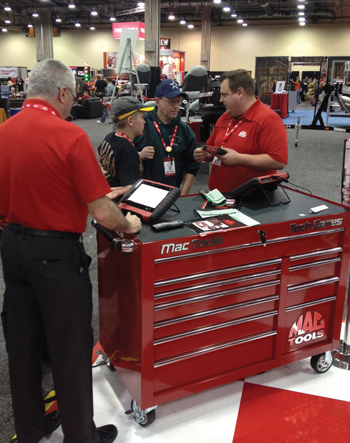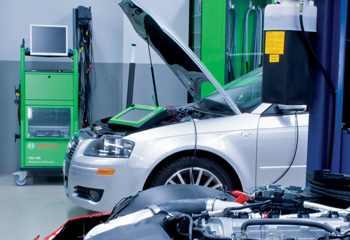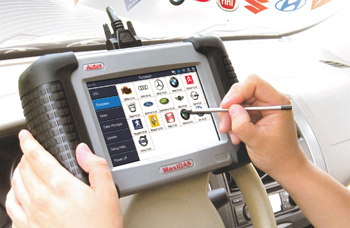 A scan tool is absolutely essential for diagnostics on today’s vehicles. You need a scan tool not only for diagnosing engine, emissions and transmission problems, but also for troubleshooting virtually any system that has electronic controls.
A scan tool is absolutely essential for diagnostics on today’s vehicles. You need a scan tool not only for diagnosing engine, emissions and transmission problems, but also for troubleshooting virtually any system that has electronic controls.
A scan tool is needed not only for reading trouble codes, sensor PIDs and other system information, but also for accessing pending codes (Mode $06 data), capturing information when a fault occurs, accessing and running various system self-tests on the vehicle, initiating relearn procedures that are often required when certain parts are replaced or electrically disconnected, and module reprogramming. In short, you need a highly capable scan tool that has a lot of built-in utility and versatility.
Buying such a tool is obviously a major investment, so you want to get the most bang for your buck.
You might acquire one or two factory scan tools for the makes you service most often, but you’ll also need some type of general-purpose aftermarket scan tool that can handle a broad range of vehicle makes.
Aftermarket scan tools run the gamut from the relatively inexpensive (under $250) DIY scan tools that are limited to reading codes and common OBD II PIDs, to high-end professional-grade scan tools that have bidirectional capabilities and software functionality similar to a factory scan tool. They can cost as much as $5,000 to $12,000 or more, depending on features, adapters and cables that may be bundled with it.
In recent years, there has also been a growing trend toward the “global” all makes/all models scan tool, recognizing the fact that independent repair shops can’t afford to buy and maintain a different scan tool for each and every make of vehicle their customers may drive.
Aftermarket scan tool suppliers try to incorporate as many of the factory scan tool capabilities as possible, but they seldom achieve a complete duplication of functions. Some PIDS may be missing, some self-tests may not be included, and some systems or modules that the factory scan tool can talk to may not be accessible. These are common shortcomings you’ll still find in many high-end scan tools. Even so, considering the capabilities that are included and the cost savings they offer, a top-quality aftermarket scan tool is still one of the best buys you can make.
Common Buying Pitfalls
One of the biggest risks today is getting burned on a factory or aftermarket scan tool that is a knock-off of the real thing. A lot of copycat and counterfeit scan tools are coming out of China that appear to be the genuine product. The problem is they are often unauthorized copies of the brand-name product and they may or may not function as claimed, so when it comes time to upgrade the software, you discover your tool lacks the proper authorization codes for the required upgrade. Many of these tools are being sold online or by fly-by-night distributors who don’t have a permanent address or contact information.
A scan tool supplier will usually list all of the vehicle makes they cover, but the more important question is, what is the depth of coverage for each of the makes listed? Is it only generic OBD II codes and PIDs, or does it include in-depth factory codes, PIDs, self-tests and other diagnostic functions?
Many aftermarket scan tools provide excellent in-depth coverage on the more popular vehicle makes, but many have only limited diagnostic capabilities for some of the less common makes.
The problem is you often don’t know what’s lacking in a scan tool until you’re actually using it on a customer’s vehicle. It’s at that point you discover the tool can’t give you a definition for a certain code, it can’t access the subsystem you’re trying to work on, it can’t display a full list of PIDs, it can’t run a certain self-test you may need to diagnose a fault, or it can’t initiate a required relearn procedure that may be needed to complete a repair. It may be a great tool for working on some vehicles, but is of little value on others. That’s still one of the greatest pitfalls of buying a scan tool today.
The best advice we can offer here is to do as much homework before you buy a particular tool so you know what you are buying. Review the scan tool supplier’s product information, make sure the tool covers the makes you work on, then look for online reviews by others who have had some experience with the tool. If possible, talk to other techs who own a similar tool to find out what their experience has been.
More Considerations
Cost versus value. How much can you afford to spend on a scan tool (and yearly updates) and what capabilities are you willing to forego because you can’t afford them? Wouldn’t it be great if you could buy one scan tool for around $5,000 that would do everything? That day hasn’t arrived yet, so accept the fact that you’ll probably have to buy several different scan tools to get the kind of coverage and capability to handle all of the different makes you may have to work on.
Some scan tools command a higher price because of their brand reputation or market dominance. Even so, it’s a highly competitive market and you can often get the same or better coverage and functionality in a scan tool from a lesser-known supplier for significantly less money.
Other factors to consider are things like product support (can they fix your scan tool if it breaks?), the cost of annual upgrades (and the quality and completeness of those upgrades), the availability to purchase accessories (such as cables, adapters, etc.), and the tools eventual resale value. Many brand name products still retain a high resale value after years of service, while many no-name products become almost worthless after a few years.
A professional-grade aftermarket scan tool must offer factory-equivalent functionality. It must have bi-directional capability for all of the reasons already mentioned. It’s also helpful if the tool is J2534 compliant so it can be used to reprogram the PCM and other on-board modules if a reflash is needed to correct a particular driveability, emissions or performance problem. The ability to record and graph data is also a useful feature to have for diagnostic purposes. The tool should also be able to access systems beyond the powertrain (such as ABS, suspension, steering, climate control, air bags, etc.).
The ability to work on pre-OBD II vehicles is still useful. Though this population of vehicles is shrinking, many import owners may keep a prized vehicle in the family for years, passing it along from one generation to the next. If you can’t fix it, who can? These older vehicles typically require a box full of adapters and cables to interface with their on-board electronics.
Some suppliers sell their adapters individually so you have to buy only the ones you need, while others bundle their adapters and cables in a kit and force you to buy a lot of stuff you may never use. Check these options out ahead of time so you know what accessories and options are available.
Do you want a scan tool that has wireless Bluetooth capabilities? Wireless eliminates the need for cumbersome cables and allows the scan tool to communicate with other computers, shop equipment or a printer. You may or may not find this feature useful, depending on your circumstances and bay layout.
Another consideration is the type of platform you want. Do you want a more traditional hand-held scan tool or would you prefer a tablet device? You can also get software for converting a laptop or notebook computer into a scan tool. This approach eliminates the cost of buying hardware if you already own a laptop or notebook computer. But, a converted laptop or notebook will lack some of the key features that are often built into or added to a dedicated scan tool device, such as the ability to function as a multimeter or a J2534 pass-thru device.
A scan tool with a large color screen is easier to read and can display more information than a tool with a relatively small screen. So, you have to ask yourself, is it worth the extra money to spend more for a scan tool that has a more appealing and useful interface? Most of those who opt for the better display screen never regret their decision.
Also consider the on-board memory. The greater the memory capacity of a scan tool, the better. Tools that use a standard SD memory card can be easily and cheaply upgraded with a higher-capacity SD card if the need arises. Scan tools with fixed built-in memory chips cannot.
What about battery life and power source? Is the tool powered through the OBD II connector, or does it have its own internal power supply? What is the working time of the batteries, and is it long enough for a typical work day in your shop? Can the batteries be easily and cheaply replaced, or does the tool have a built-in or proprietary battery that is expensive to replace if it fails?
How quickly does the tool turn on? The longer you have to wait for the tool to boot up, the less billable time you have to spend diagnosing and repairing the vehicle. Some scan tools are still quite slow to initiate and may require scrolling through a number of vehicle information input menus before it will display any vehicle data or codes.
How easy is the tool to use? Are the menus intuitive and easy to follow? Can you get to the vehicle information you want quickly and easily? Are the input and scrolling buttons logically positioned on the tool and easy to operate? The only way to know is to play around with the tool so you can experience first-hand how it actually functions. The interface on some tools can be rather confusing or awkward to use.
Final Thoughts
The scan tool is only a device that allows you to interface and communicate with the vehicle’s onboard electronics. You still have to understand the information you are looking at and how to use that information to fix the car. In many cases, you will have to reference other sources of information, such as factory TSBs or factory repair procedures (especially if a repair requires a special reprogramming or relearn procedure).
You also can’t rely on codes alone to diagnose every problem you may encounter. Some problems never set a code. Some codes tell you only that a problem is occurring, but provide no clue as to what might be causing it (such as a P0300 misfire code). Other codes may be false codes that can never be eliminated by normal repair procedures. You may have to reflash a module to correct the fault.
Some scan tools incorporate a service information database that can provide additional help and guidance when you encounter certain codes or types of problems. This is a very useful feature to have, especially if you find yourself at a diagnostic dead-end having only codes and PIDs. Of course, you will pay extra for this kind of information in the cost of the tool and/or the software updates. But, if it saves a comeback or having to send a repair job somewhere else, isn’t it worth it?
The best scan tool for your shop might not be the best scan tool for another shop, and a brand of scan tool that’s number one today may be surpassed by another brand tomorrow. It’s an ever-changing and dynamic marketplace with constant innovation. So while you have more choices than ever, make sure it’s a good one.













